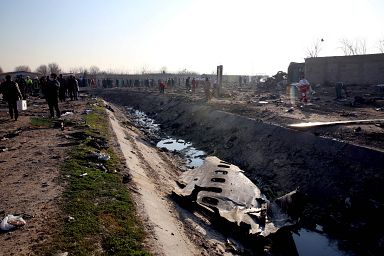Ukraine has confirmed that the victims come from at least seven nations, however Iranian media say that many were travelling on dual passports.
A Ukrainian aeroplane carrying 176 people crashed on Wednesday shortly after takeoff from Tehran's main airport, killing all on board.
Ali Abedzadeh, the head of Tehran's civil aviation organisation, said later on Wednesday that the black box flight recorders had been found.
Ukraine's foreign minister confirmed that 82 of the dead were from Iran, 63 from Canada, 11 from Ukraine, 10 from Sweden, four from Afghanistan, three from Germany and three from the UK.
However, many of the Canadians were Iranian-Canadians with dual passports.
"We express our condolences. The Ukrainian authorities continue to investigate," he said.
Canada's foreign minister says he has been in touch with the government of Ukraine upon learning about the Canadian victims.
Eds: CORRECTS: Fixes spelling of Kyiv
In a statement, Ukraine International Airlines said that flight PS752 "disappeared from the radars a few minutes after departure from Tehran International Airport."
The plane had taken off when a fire struck one of its engines, said Qassem Biniaz, a spokesman for Iran's Road and Transportation authority.
The pilot of the aircraft then lost control of the plane, sending it crashing into the ground, Biniaz said, according to the state-run IRNA news agency.
The plane carried 167 passengers and nine crew members from different nations on its flight to the Ukrainian capital, Kyiv, Biniaz said. The crash killed all on board, Iranian emergency officials and Ukraine's Foreign Ministry said.
Associated Press journalists who reached the crash site saw a wide field of debris scattered across farmland. The dead lay among shattered pieces of the aircraft. Rescuers in masks shouted over the noise of hovering helicopters as they worked.
The crash came hours after Iran launched a ballistic missile attack targeting two bases in Iraq housing U.S. forces in retaliation for the killing of Revolutionary Guard Gen. Qassem Soleimani.
Crashed model was a Boeing 737-800
The Boeing 737-800 is a very common single-aisle, twin-engine jetliner used for short to medium-range flights. Thousands of the planes are used by airlines around the world.
Introduced in the late 1990s, it is an older model than the Boeing 737 MAX, which has been grounded for nearly 10 months following two deadly crashes.
A number of 737-800 aircraft have been involved in deadly accidents over the years.
In March 2016, a FlyDubai 737-800 from Dubai crashed while trying to land at Rostov-on-Don airport in Russia, killing 62 onboard. Another 737-800 flight from Dubai, operated by Air India Express, crashed in May 2010 while trying to land in Mangalore, India, killing more than 150 onboard.
Chicago-based Boeing Co. was "aware of the media reports out of Iran and we are gathering more information,” spokesman Michael Friedman told The Associated Press.
Boeing, like other airline manufacturers, typically assists in crash investigations. However, that effort in this case could be affected by the U.S. sanctions campaign in place on Iran since President Donald Trump unilaterally withdrew from Tehran's nuclear deal with world powers in May 2018.
Both Airbus and Boeing had been in line to sell billions of dollars of aircraft to Iran over the deal, which saw Tehran limit its enrichment of uranium in exchange for the lifting of economic sanctions. But Trump's decision halted the sales.
Under decades of international sanctions, Iran's commercial passenger aircraft fleet has aged, with air accidents occurring regularly for domestic carriers in recent years, resulting in hundreds of casualties.












